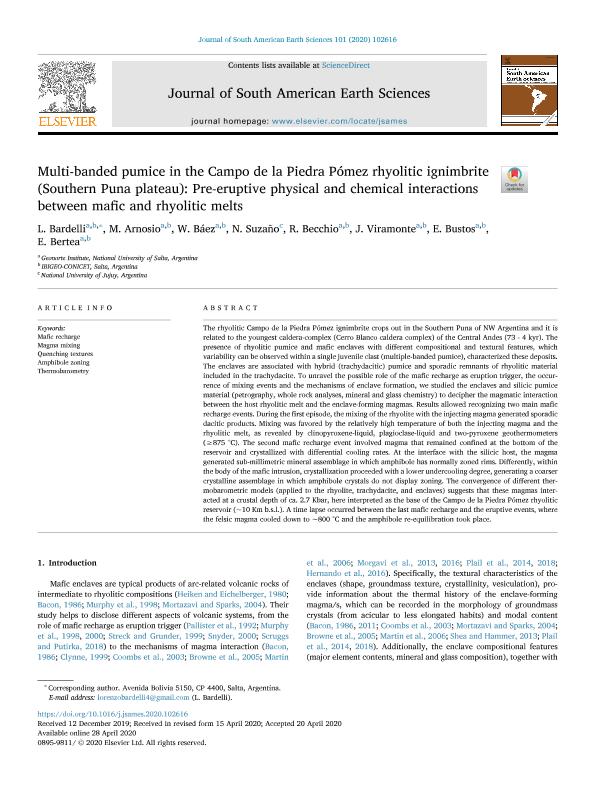Artículo
Multi-banded pumice in the Campo de la Piedra Pómez rhyolitic ignimbrite (Southern Puna plateau): Pre-eruptive physical and chemical interactions between mafic and rhyolitic melts
Bardelli, Lorenzo ; Arnosio, José Marcelo; Baez, Walter Ariel
; Arnosio, José Marcelo; Baez, Walter Ariel ; Suzaño, Nestor Omar
; Suzaño, Nestor Omar ; Becchio, Raul Alberto
; Becchio, Raul Alberto ; Viramonte, Jose German
; Viramonte, Jose German ; Bustos, Emilce
; Bustos, Emilce ; Bertea, Esteban Santiago
; Bertea, Esteban Santiago
 ; Arnosio, José Marcelo; Baez, Walter Ariel
; Arnosio, José Marcelo; Baez, Walter Ariel ; Suzaño, Nestor Omar
; Suzaño, Nestor Omar ; Becchio, Raul Alberto
; Becchio, Raul Alberto ; Viramonte, Jose German
; Viramonte, Jose German ; Bustos, Emilce
; Bustos, Emilce ; Bertea, Esteban Santiago
; Bertea, Esteban Santiago
Fecha de publicación:
28/04/2020
Editorial:
Pergamon-Elsevier Science Ltd
Revista:
Journal of South American Earth Sciences
ISSN:
0895-9811
Idioma:
Inglés
Tipo de recurso:
Artículo publicado
Clasificación temática:
Resumen
The rhyolitic Campo de la Piedra Pómez ignimbrite crops out in the Southern Puna of NW Argentina and it isrelated to the youngest caldera-complex (Cerro Blanco caldera complex) of the Central Andes (73 - 4 kyr). Thepresence of rhyolitic pumice and mafic enclaves with different compositional and textural features, whichvariability can be observed within a single juvenile clast (multiple-banded pumice), characterized these deposits.The enclaves are associated with hybrid (trachydacitic) pumice and sporadic remnants of rhyolitic materialincluded in the trachydacite. To unravel the possible role of the mafic recharge as eruption trigger, the occurrenceof mixing events and the mechanisms of enclave formation, we studied the enclaves and silicic pumicematerial (petrography, whole rock analyses, mineral and glass chemistry) to decipher the magmatic interactionbetween the host rhyolitic melt and the enclave-forming magmas. Results allowed recognizing two main maficrecharge events. During the first episode, the mixing of the rhyolite with the injecting magma generated sporadicdacitic products. Mixing was favored by the relatively high temperature of both the injecting magma and therhyolitic melt, as revealed by clinopyroxene-liquid, plagioclase-liquid and two-pyroxene geothermometers(≥875 °C). The second mafic recharge event involved magma that remained confined at the bottom of thereservoir and crystallized with differential cooling rates. At the interface with the silicic host, the magmagenerated sub-millimetric mineral assemblage in which amphibole has normally zoned rims. Differently, withinthe body of the mafic intrusion, crystallization proceeded with a lower undercooling degree, generating a coarsercrystalline assemblage in which amphibole crystals do not display zoning. The convergence of different thermobarometricmodels (applied to the rhyolite, trachydacite, and enclaves) suggests that these magmas interactedat a crustal depth of ca. 2.7 Kbar, here interpreted as the base of the Campo de la Piedra Pómez rhyoliticreservoir (~10 Km b.s.l.). A time lapse occurred between the last mafic recharge and the eruptive events, wherethe felsic magma cooled down to ~800 °C and the amphibole re-equilibration took place.
Archivos asociados
Licencia
Identificadores
Colecciones
Articulos(CCT - SALTA-JUJUY)
Articulos de CTRO.CIENTIFICO TECNOL.CONICET - SALTA-JUJUY
Articulos de CTRO.CIENTIFICO TECNOL.CONICET - SALTA-JUJUY
Articulos(IBIGEO)
Articulos de INST.DE BIO Y GEOCIENCIAS DEL NOA
Articulos de INST.DE BIO Y GEOCIENCIAS DEL NOA
Citación
Bardelli, Lorenzo; Arnosio, José Marcelo; Baez, Walter Ariel; Suzaño, Nestor Omar; Becchio, Raul Alberto; et al.; Multi-banded pumice in the Campo de la Piedra Pómez rhyolitic ignimbrite (Southern Puna plateau): Pre-eruptive physical and chemical interactions between mafic and rhyolitic melts; Pergamon-Elsevier Science Ltd; Journal of South American Earth Sciences; 101; 102616; 28-4-2020; 1-25
Compartir
Altmétricas



